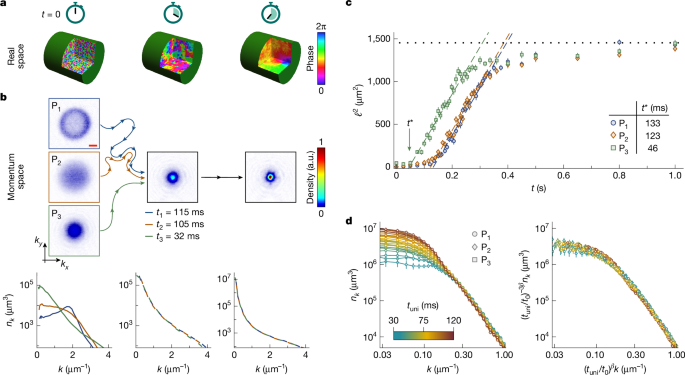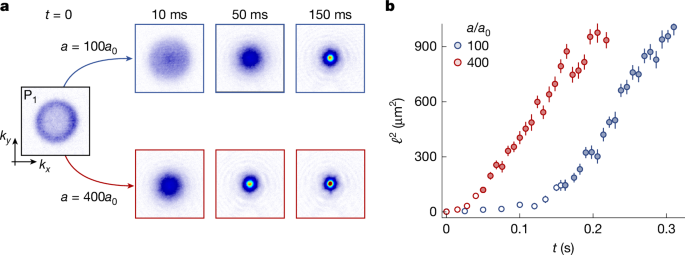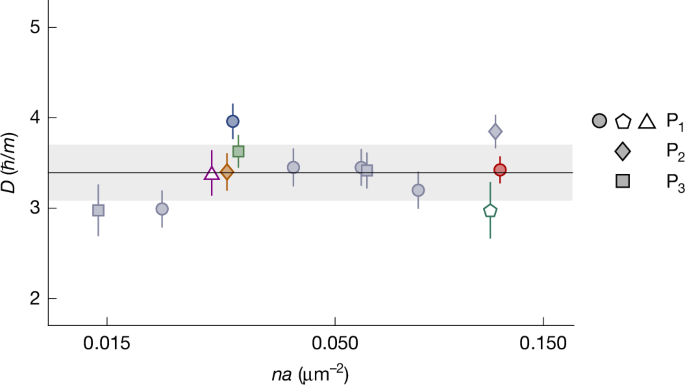Understanding the dynamics of far-from-equilibrium many-body systems, including the emergence of long-range order in such systems, is an outstanding problem in physics, relevant from subnuclear to cosmological length scales21,22,23,24,25,26,27,28,29,30,31,32,33,34. Conceptually, far-from-equilibrium relaxation and emergence of coherence have long been linked to decaying turbulence12,21,23,27, which often features self-similar scaling dynamics. More recently, within the framework of nonthermal fixed points (NTFPs)28, theorists have drawn analogies between such dynamics and the equilibrium properties of systems close to a continuous phase transition. Near the transition to an ordered state of matter, such as a superfluid or a ferromagnet, the system is scale-invariant and its salient properties do not depend on the microscopic details35. Analogously, in the NTFP theory, far-from-equilibrium systems, including the early universe undergoing reheating27, quark–gluon plasma in heavy-ion collisions36, quantum magnets37, and ultracold atomic gases38,39,40,41,42,43, generically show dynamic (spatiotemporal) scaling, with scaling exponents that could define far-from-equilibrium universality classes. Recently, far-from-equilibrium dynamic scaling was observed in several experiments with ultracold atoms, in both isolated (relaxing)44,45,46,47,48,49,50 and continuously driven51,52 systems.
Here we go beyond the elegant scaling properties of far-from-equilibrium relaxation44,45,46,47,48,49,50 to address the crucial question of how long it takes to establish long-range order. We study this problem for the paradigmatic macroscopically coherent state, the weakly interacting Bose–Einstein condensate, which is also a textbook example of a superfluid.
We study condensate formation in an isolated homogeneous Bose gas53, trapped in a cylindrical optical box19,20, such as sketched in Fig. 1a (Methods). The gas is prepared far from equilibrium and is initially incoherent but has very low energy and condenses as it relaxes towards equilibrium under the influence of interatomic interactions, characterized by the s-wave scattering length a. As illustrated in Fig. 1a, in a homogeneous system, the (global) condensate grows through coarsening25, the local spreading of coherence. This coarsening is quantified by the growth of the coherence length ℓ, over which the first-order correlation function g1(r) decays, and corresponds to narrowing of the momentum distribution nk(k) (in which k is the wavenumber), which is related to g1(r) by the Fourier transform.
a, Real-space cartoon of coarsening. b, Momentum-space relaxation for different far-from-equilibrium initial states. Our initial states P1,2,3 (left column) have different momentum distributions nk but the same energy, so the gas always relaxes towards the same equilibrium state. For P1,2,3, the system takes different times, t1,2,3, to evolve to the same nk shown in the middle column, but from this point onwards, it always evolves in the same way. The nk distributions are averages of at least 20 measurements. The red scale bar (top image) denotes 1 μm−1. c, Growth of the coherence length, ℓ (see text). Plotting ℓ2(t) reveals three stages of relaxation: (1) the non-universal initial dynamics; (2) the scaling regime in which ℓ2 grows linearly (dashed lines), as expected for the scaling exponent β = 1/2; and (3) the breakdown of scaling at long times owing to finite-size effects. The curves for P1,2,3 are parallel, with the initial-state effects captured by the different time offsets t* (intercepts of the dashed lines). d, Dynamic scaling. In the scaling regime, the full low-k distributions for all three initial states (left panel) can be collapsed onto the same curve (right panel) according to equations (2) and (3) with β = 1/2 and t → tuni ≡ t − t*; t0 = 60 ms is an arbitrary reference time. All error bars show standard errors of the measurements. a.u., arbitrary units.
Our experiments are performed with 39K atoms and we tune a using a Feshbach resonance, exploring coarsening for a = (50–400)a0, in which a0 is the Bohr radius. Our cylindrical box has radius R = 21(2) μm, length L = 40(4) μm, and volume V = 55(12) × 103 μm3. Our gas density, n = 5.4(1.2) μm−3, corresponds (assuming ideal-gas thermodynamics) to the critical temperature for condensation Tc = 127(19) nK. The kinetic energy per particle in our initial incoherent states is ε = kB × 20(2) nK (in which kB is the Boltzmann constant), corresponding to a large equilibrium condensed fraction η = 0.61(4) (see Extended Data Figs. 1 and 2). During coarsening, the total particle number, N ≈ 3 × 105, is essentially constant (see Methods) and the gas is always weakly interacting in the sense that na3 < 10−4. We measure nk by absorption imaging (along the z direction) after time-of-flight expansion, performing the inverse Abel transform on the line-of-sight integrated distributions; just for the images shown in Figs. 1b and 2a, we instead image only slices of the cloud54 corresponding to kz ≈ 0 (Methods). We normalize nk such that ∫nk4πk2dk = N.
We first show that, although the short-time relaxation dynamics inevitably depend on the details of the initial state, the long-time relaxation does not (Fig. 1b). For this purpose, we engineer three different far-from-equilibrium states, starting with a quasi-pure condensate and using a time-varying force to perturb the cloud (see Extended Data Fig. 1). Our initial states P1,2,3 have different nk (see left column) but the same ε. At time t = 0, the gas is non-interacting and we then initiate relaxation by switching a to 100a0. Starting from an initial state, nk(k) follows some trajectory (represented by the wavy coloured lines) in the space of functions with the same N and ε. The middle column shows that, still far from equilibrium, these trajectories converge to the same nk. The time that the gas takes to evolve to this nk depends on the initial state (ti=1,2,3 for Pi=1,2,3) but further evolution from this nk is the same for all initial states; note that the state trajectories for P1 and P2 merge before merging with the P3 trajectory, but we just show an nk for which all three have converged.
The long-time relaxation of a low-energy Bose fluid was theoretically studied in different frameworks. In ref. 23, this problem was studied for an incompressible superfluid, for which the spreading of coherence is associated with the decay of a random tangle of quantized vortices (variously known as the Kibble’s vortex tangle22, superfluid turbulence55 and Vinen turbulence26,33) and ℓ is set by the typical distance between the vortex lines. For ℓ ≫ ξ, in which ξ is the size of the vortex core, the prediction is that
$$\frac{{\rm{d}}{\ell }}{{\rm{d}}t}\propto \frac{{\rm{ln}}(A{\ell }/\xi )}{{\ell }},$$
(1)
in which A is a dimensionless constant. On the other hand, for coarsening of wave excitations, corresponding to a compressible-fluid flow, approximate kinetic equations give
$${\ell }(t)\propto {t}^{\beta },$$
(2)
with β = 1/2 (refs. 21,34,39,41). In our weakly interacting gas, with the vortex-core size set by the healing length \(\xi =1/\sqrt{8{\rm{\pi }}na}\), both vortices and waves could play a substantial role. Note, however, that the predictions of equations (1) and (2) differ only in a logarithmic correction. Moreover, our measurements of nk reveal ℓ independently of what type of excitations are dominant and limit its value.
For coarsening fully characterized by the growth of ℓ (ref. 25), the low-k momentum distribution exhibits self-similar evolution:
$${n}_{k}(k,t)={{\ell }}^{d}(t)f(k{\ell }(t)),$$
(3)
in which d = 3 is the system dimensionality and f is a dimensionless scaling function. In this case, ℓ(t) is \(\propto {n}_{0}^{1/3}(t)\), in which n0 ≡ nk (k = 0) and the condensate occupation is N0 = (2π)3n0/V. This scaling does not define the absolute value of ℓ and here we define it so that ℓ3 is equal to the system volume when the gas is in equilibrium; to convert the observed n0 values to ℓ, we also take into account the finite k-space resolution of our time-of-flight measurements (Methods). We observe good agreement with equations (2) and (3), without the need to invoke the logarithmic correction in equation (1), but this does not exclude its relevance on much larger length scales; note also that the importance of this correction depends on the unknown value of A.
To compare our data to equation (2), we first note that it is formally valid only for t, ℓ → ∞. However, one can observe the same scaling for finite t and ℓ by absorbing all the effects of the non-universal initial dynamics into time offsets such as seen in Fig. 1b, that is, by shifting t → t − t*, in which t* depends on the initial state49 (see also ref. 56).
For β = 1/2, in the scaling regime ℓ ∝ (t − t*)1/2 and in Fig. 1c we plot ℓ2(t). This reveals both the scaling regime in which ℓ2 grows linearly, at a rate that does not depend on the initial state (dashed lines), and the offsets t* for P1,2,3; see also Extended Data Fig. 3. As the system approaches equilibrium, for ℓ2 ≳ 900 μm2 ≈ (V/2)2/3, the scaling breaks down owing to finite-size effects; from here on, we focus on the regime before this breakdown.
In Fig. 1d, using the t* values from Fig. 1c, we show that, in the scaling regime, the low-k momentum distributions for all three initial states can indeed be collapsed onto the same universal curve according to equation (3) with ℓ ∝ (t − t*)1/2 (see also Extended Data Fig. 4).
We now turn to varying the strength of the interactions that drive the coarsening and study how this affects the coarsening rate. For ℓ ∝ (t − t*)β, we define the ‘speed of coarsening’ as D ≡ dℓ1/β/dt, which is (for any β) time-invariant in the scaling regime and does not depend on the non-universal t*. For a low-energy Bose gas described by the Gross–Pitaevskii equation, the interactions-set units of length and time are ξ and tξ ≡ mξ2/ħ, in which ħ is the reduced Planck’s constant and m the atom mass. Hence, on dimensional grounds, ℓ/ξ ∝ ((t − t*)/tξ)β and we get
$$D\propto \frac{{\xi }^{1/\beta }}{{t}_{\xi }}\propto \frac{{\hbar }}{m}{(na)}^{1-1/(2\beta )}.$$
(4)
Specifically for β = 1/2, as observed in Fig. 1, this has a counter-intuitive implication that D = dℓ2/dt ∝ ħ/m does not depend on the interaction strength na (see also refs. 21,24). In the hydrodynamic theory of ref. 23, the same result emerges if we neglect the logarithmic correction in equation (1) (which depends on the interactions through ξ), because then dℓ2/dt can only be set by the quantum of velocity circulation associated with a quantum vortex, κ = 2πħ/m.
In Fig. 2, we show data for coarsening at a = 100a0 and 400a0, starting from the same initial state P1; the 100a0 data here is the same as in Fig. 1. The images in Fig. 2a show what we intuitively expect—for larger a, the condensate emerges sooner. However, in Fig. 2b, plotting ℓ2(t) reveals that the effects of the interaction strength are, just like the initial-state effects, confined to the difference in the non-universal t*—in the scaling regime (solid symbols), the rate of the linear growth of ℓ2 is essentially the same for both a.
a, Gas evolution for two different scattering lengths a, starting in the same initial state P1. For stronger interactions, the condensate (the peak at k = 0) emerges sooner. b, However, plotting ℓ2(t) reveals that the interaction strength affects only the non-universal initial dynamics (open symbols), whereas the linear growth of ℓ2 in the universal coarsening regime (solid symbols) is the same for both a values. Panels in a and data points in b show averages based on at least 20 measurements. All error bars show standard errors of the measurements.
We performed such measurements for various scattering lengths and also varied the gas density and system size (see also Extended Data Fig. 5). In each case, we fit the slope D = dℓ2/dt in the scaling regime and summarize our results in Fig. 3. We observe no systematic variation of D with the interaction strength na and obtain a combined estimate D = 3.4(3)ħ/m; here the error in D is purely statistical, whereas the uncertainty in our box volume leads to a systematic error of ±0.5ħ/m (Methods).
Our measurements for various interaction strengths show no systematic variation of D = dℓ2/dt (in the scaling regime) and give a combined estimate D = 3.4(3)ħ/m (solid line and shading). The four datasets shown in Figs. 1c or 2b are represented here by the corresponding coloured symbols. The purple triangle indicates a measurement for which we reduced the gas density n by a factor of 4.2, which reduces Tc ∝ n2/3 and the equilibrium condensed fraction (from about 60% to about 30%) but does not affect D. The green pentagon indicates a measurement for which we instead reduced the system volume V by a factor of 3.5; in this case, ℓ2 saturates at a correspondingly lower value (∝ V2/3) but again D is not affected. For details on the data taken with reduced n or V, see Extended Data Fig. 5. The data points corresponding to the same na values are slightly offset horizontally for visual clarity. The error bars reflect fitting errors.
Finally, in Fig. 4, we study how the system approaches the long-time coarsening speed D, which also reconciles our observations with the finite-system intuition (and experience) that, for stronger interactions, condensates form faster, and for a → 0, they do not form at all.
a, The growth of ℓ2 for the same initial state (P1) and gas density but different a. All curves start at t = 0 and plotting them versus t − t* (with a-dependent t*) collapses them in the universal scaling regime. The dashed line shows ℓ2 = D(t − t*). For weaker interactions, the system approaches this speed limit slower and reaches it at a larger ℓ; the solid lines show exponential fits to the early-time data. b, When expressed in the interactions-set units of length, \(\xi =1/\sqrt{8{\rm{\pi }}na}\), and time, tξ ≡ mξ2/ħ, all of our data for different Pi, a, V, and n (see Fig. 3) collapse onto a single curve, meaning that the speed limit is always reached at the same ℓ/ξ. The solid line shows exponential growth with a time constant τ = 56tξ and the dashed line has slope mD/ħ = 3.4. c, Numerically differentiating the data in b, we eliminate the non-universal t* and show as a function of (ℓ/ξ)2 how dℓ2/dt approaches the universal D = 3.4ħ/m and then stops growing; the solid and dashed lines are the same functions as in b. For weaker interactions (larger ξ), observing this speed limit requires a larger physical system. The data points show averages based on at least 20 measurements. All error bars show standard errors of the measurements.
As we illustrate in Fig. 4a for fixed n, the same initial state (P1) and three values of a, for weaker interactions the gas takes longer to join the universal scaling trajectory and joins it at a larger value of ℓ. Here all curves start at t = 0 and plotting versus t − t* collapses them in the scaling regime; the dashed line shows ℓ2 = D(t − t*).
In Fig. 4b, we show that expressing all of our data for different Pi, a, V, and n (see Fig. 3) in terms of ξ and tξ collapses them onto a single curve. Here the dashed line has slope mD/ħ = 3.4 and the solid line that captures the approach to the scaling regime is an exponential with a time constant τ = 56tξ (see also Extended Data Fig. 6). Numerically differentiating these data, and thus eliminating the non-universal t*, in Fig. 4c, we show how dℓ2/dt approaches the universal D = 3.4ħ/m (dashed line) as a function of (ℓ/ξ)2.
The dimensionless results in Fig. 4b,c imply that, for any interaction strength, the system would eventually, for ℓ ≫ ξ, exhibit the same coarsening speed D. However, the system size required to observe this is larger for larger ξ (smaller na) and diverges for na → 0. As we discuss in Methods and Extended Data Fig. 7, previous experiments on the emergence of extended coherence during far-from-equilibrium condensation, in both harmonic14 and box46 traps, were not in the universal-speed regime; consequently, for tunable interactions in ref. 46, the observed relaxation time was ∝ 1/a.
Our results should be relevant across many fields, from cold atoms and the conventional low-temperature physics26,33 to cosmology22,27 and high-energy physics40. The fact that ħ and m appear in D only through their ratio, or the quantum of circulation κ, implies that the results are also applicable to systems in which the underlying physics is not quantum57. They should also be relevant for benchmarking the theories of ultrarelativistic systems, for which β = 1/2 is also predicted39, but—in that case—the effective mass, meff ∝ ħ/(ξc) (in which c is the speed of light) and hence D ∝ξc depend on the interactions.
The value of D = 3.4ħ/m, equal to 5.5 μm2 ms−1 for 39K, has curious implications for the emergence of coherence on truly macroscopic length scales. For example, for coherence to spread by means of coarsening over more than 1 cm would require hours, and even possible logarithmic corrections cannot change this conclusion substantially. However, an interesting question is whether this speed limit can be broken by a fundamentally different preparation protocol, for example, by melting a Mott insulator (through a quantum phase transition) to obtain a superfluid with long-range coherence.
In the future, it would be interesting to disentangle the roles of waves and vortices during coarsening, by directly imaging the latter, to search for possible logarithmic corrections to the coarsening speed, and to perform similar measurements for fermionic superfluids and gases with long-range interactions.






